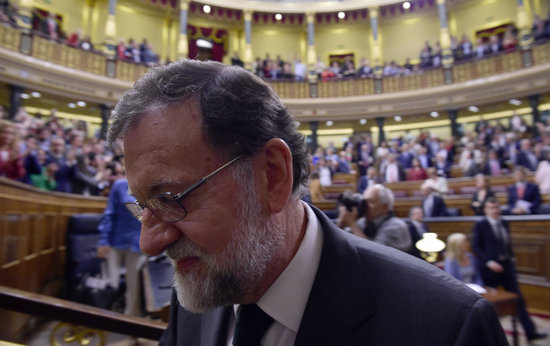Rajoy and Catalonia: a troublesome story
Ousted Spanish president took exceptional measures to crush the independence bid

Mariano Rajoy was ousted as Spanish president on Friday following a parliamentary no-confidence motion triggered by a corruption scandal. Catalan pro-independence parties were instrumental in putting an end to Rajoy’s rule and appointing Socialist leader Pedro Sánchez in his place—an unlikely alliance only made possible by a common foe.
In power since 2011, Rajoy has been Spain’s central figure in its response to Catalonia’s push for independence from the outset of the movement, and throughout the escalation that led to a referendum and a declaration of independence last October, which plunged Spain into the country’s worst political crisis in decades.
The emergence of the independence bid is inseparable from Rajoy’s decisions as head of the Spanish government. In 2012, in the midst of the economic crisis, the then Catalan president Artur Mas asked Rajoy for a better financial deal. Rajoy said no. In response, Mas called a snap election and won by championing a new demand: a referendum to decide on independence.
Although a majority of lawmakers in Catalonia supported a referendum, Rajoy blocked all attempts to agree on a vote. In 2014, the Spanish parliament dismissed the petition with 299 votes against and only 47 in favor—including those of Catalan parties.
Carles Puigdemont would eventually replace Mas as the head of Catalonia’s pro-independence government. Again, he opened talks with Rajoy about holding a referendum. He received the same answer as his predecessor: independence from Spain is not a matter for discussion.
The Catalan government held an unofficial vote on independence in 2014, with a 40% turnout and with 80% of those people voting to leave. Spain banned the vote, but let it go ahead.
Puigdemont pledged to organize another vote on independence despite Rajoy’s opposition. This time, though, the results would be binding—which means that independence would be declared should the ‘yes’ vote be the preferred option.
In the meantime, Rajoy lost his absolute majority in the Spanish parliament following two consecutive elections that ended in deadlock. As opposition parties failed to form an alternative government, Rajoy stayed in power with the support of the liberal Ciutadans—a party with a hardline stance against Catalan independence.
Unlike the 2014 vote, the Spanish government pledged to stop the new referendum. Rajoy sent thousands of police officers to Catalonia in order to halt preparations for the vote, deemed illegal by the judiciary.
Despite Spain’s opposition, the referendum went ahead on October 1, 2017. In an operation criticized by international organizations for its “excessive use of force,” police officers cracked down on voters and left more than a thousand people injured, according to Catalan government figures.
Catalan parties went on to declare independence following a ‘yes’ victory and a 43% turnout. In an unprecedented move in Spain’s democratic history, Rajoy triggered Article 155 of the Constitution to impose direct rule on Catalonia, sack Puigdemont and all his ministers, and call a new election. Rajoy was backed by Ciutadans, as well as the Socialists—with whom pro-independence parties would subsequently unite to oust Rajoy.
Rajoy would then take a backseat role as the courts entered the ring to prosecute Catalan leaders. As of today, and with a final trial still pending, there are nine pro-independence leaders preemptively jailed in Madrid and seven more seeking refuge from prosecution in other European countries.
Puigdemont was among those who traveled abroad. Although standing from Brussels, the deposed president managed to secure enough seats in last December’s election to reclaim his post. The Catalan branch of Rajoy’s People’s Party (PP) got its worst result in decades and became the smallest party in Parliament with four MPs.
Yet, the Spanish courts blocked all attempts to appoint Puigdemont, as well as other candidates subsequently put forward, who were also facing prosecution for their role in the independence bid. Rajoy remained in control of the Catalan government all this time.
Pro-independence parties would eventually elect Quim Torra as president. He pledged to reinstate the ministers dismissed by Rajoy last October, who were either in jail or abroad, but the Spanish president used his rule over Catalonia to block the appointments.
In order to unblock the political standstill, Torra gave up on his promise and nominated alternative candidates. In one of his last decisions as Spanish president before being ousted, Rajoy greenlighted the new cabinet and authorized direct rule to be lifted with the formation of a new government on Saturday.
Where it all began
Mas put the call for a new state at the center of Catalan politics. Yet the pro-independence movement was already looming at the grassroots level. Shortly before the meeting in Madrid, a massive demonstration flooded the streets of Barcelona with a clear motto: “Catalonia, a new state in Europe.” The first clear-cut pro-independence rally of many to come.
In 2010, another huge demonstration in the Catalan capital paved the way for the outset of the pro-independence movement. People gathered to protest against a Spanish Constitutional Court ruling, which cut down a new Statute of Autonomy backed by Catalan parties.
The regional carta magna was brought to court by Spain’s People’s Party (PP), which launched a country-wide campaign against the text. The party was already led by the then head of the opposition Mariano Rajoy.